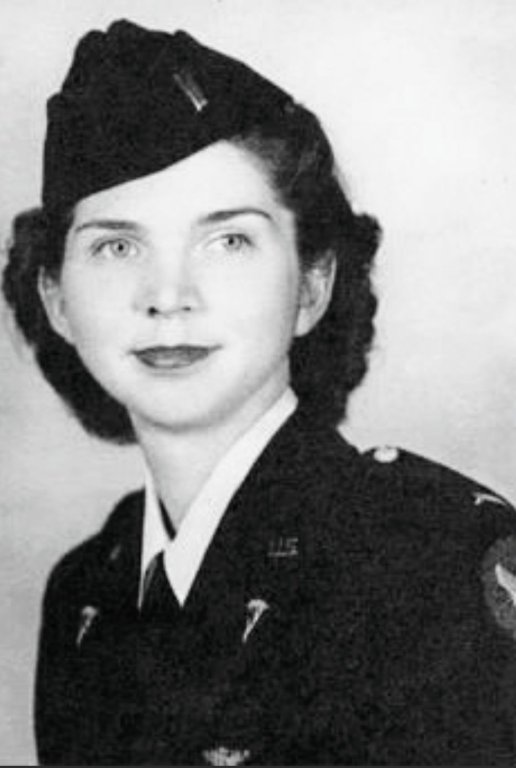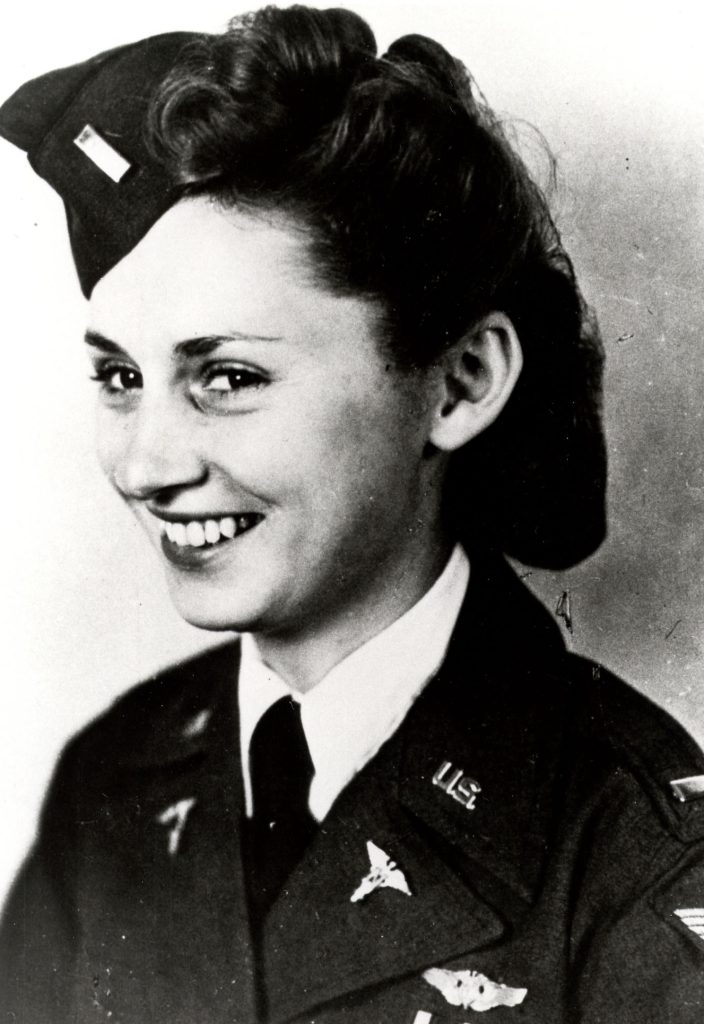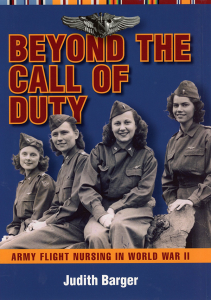“Fate dealt us another unlucky blow”
Part 1
January and February 2024 mark the eightieth anniversary of two tragic events in the 807 Medical Air Evacuation Squadron [MAES] assigned to the Mediterranean Theater during WW2 in which three of the squadron’s flight nurses, all 26 November 1943 graduates of the flight nurse course at the School of Air Evacuation, Bowman Field, KY, lost their lives in two separate accidents.
“Fate dealt us another unlucky blow,” began Chief Nurse and unit historian CPT Grace Stakeman, who, documenting the 807 MAES activities for 30 January 1944, described the first accident. Three of her flight nurses – 2LT Mary G. Allen from Corbin, KY, 2LT Dorothy M. Booth from South Hills, PA, and 2LT Mildred W. Wallace from Uniontown, PA – were returning to their squadron from a dance in Catania, Sicily with three officers from the 342 Service Squadron at one o’clock in the morning when the jeep in which they were riding slid on wet pavement and overturned. The accident badly injured all three nurses, who were admitted to the base hospital twenty minutes later.
2LT WALLACE
LT Wallace, whose skull base fracture was the most serious, died from her injuries just over two hours after admission to the hospital. Her funeral was held the next day, 31 January 1944, in the Wing Theater on base, with squadron personnel and others who wanted to attend gathered to pay tribute to her. The squadron history notes that the service was “Very nicely done” with “Plenty of flowers on the makeshift coffin.” The entry concludes, “An ambulance then carried the coffin to the airport with the pallbearers riding behind in procession form.” Burial was at the temporary GELA Military Cemetery near Pontelivia, Sicily.
“Find a Grave” states that the cemetery was opened shortly after the invasion of Sicily in World War II and that:
Over 1,200 young American men and women were buried in this cemetery between 20 July 1943 and July 1944. In 1947 all were exhumed and reburied in the Mount Soprano/Paestum cemetery on the Italian mainland. From there the remains were either repatriated or buried in one of the cemeteries in Europe.
After the war LT Wallace was repatriated and buried in the Redstone Cemetery in Uniontown, PA.
https://www.findagrave.com/virtual-cemetery/297664
2LT ALLEN
LT Allen, who had a dislocation of her shoulder, was hospitalized for just over three weeks and discharged on 24 February “sick to quarters,” since her arm and shoulder were still strapped. She was back on flying status by 3 March, when she flew to Cairo.
2LT BOOTH
LT Booth suffered numerous facial and head lacerations, fractured teeth, and a twelfth-vertebra fracture – injuries that would require approximately eight months of recovery. Placed in a full body cast, she was taken to the airfield on 24 February for the first leg of a journey that likely would return her to the United States.
The flight on “Plane #61”, a C-47 aircraft 41-7723 or 41-7725 of the 12th Troop Carrier Squadron, 61st Troop Carrier Group out of Gerbini Main, Sicily and piloted by 2LT Robert S. Smith and copilot 2LT Inez Rees, would take Booth and 14 other litter patients, all British soldiers, from Catania, Sicily to Maison Blanche, Algeria. The air evacuation crew onboard were flight nurse 2LT Elizabeth “Betty” J. Howren of New Castle, IN and surgical technician SSG [T/3] William G. Fitzpatrick from Ila, GA.
LT Howren had arrived at the 807 MAES on 7 January 1944 to fill a vacancy created when the plane in which half of the squadron’s flight nurses and enlisted technicians were flying to Italy force-landed in German-occupied Albania in early November 1943. The flight nurses and rest of the crew had to make their way out of Albania to Allied territory, mostly on foot, and had not yet returned to the squadron. See the next Blog for a description of that event. Albanian Escape: The True Story of U.S. Army Nurses Behind Enemy Lines, written by Agnes Jensen Mangerich, one of the flight nurses on that flight, gives a detailed account of the crew’s return to Sicily.

LT Elizabeth “Betty” Howran (USAF photo)
The unit history notes that Howren was a “replacement for a replacement” when a flight nurse scheduled to join the squadron suffered a spontaneous pneumothorax – a collapsed lung – on the eve of her departure for overseas. Howren quickly out-processed in one day to make the flight from Florida. After arriving in Catania, she and flight nurse colleague 2LTDorothy White from Detroit, MI, became good friends.
That Howren was on the “doomed” air evacuation mission still haunted White Errair, who originally was scheduled for the mission, 60 years later. An Orlando [FL] Sentinel article of 2004 noted: “’I woke her up. I helped her get ready,’ Errair remembers. ‘I wasn’t even feeling bad, I just had a temperature. It could have been me – it should have been me.’”

LT Dorothy White (USAF photo)
Flight nurse 2LT Charlotte Wiehrdt from Phoenix also was scheduled to fly to Algiers that morning. “Normally we took whatever plane was available,” Wiehrdt recalled in the Orlando Sentinel article. But because Booth was going out on one of the planes, and both flight nurses wanted to be with her, they “flipped a coin to see who would go in that plane.” Wiehrdt lost the coin toss, and Howren climbed aboard while Wiehrdt watched what appeared a normal takeoff.
A page from the 60th Troop Carrier Group War Diary notates what happened next. “We felt especially badly about the accident since the plane was carrying litter patients.” The patients had been picked up early that morning bound for Bizerte, and the plane encountered overcast skies; “rather than try to get over it[,] a route was chosen following a canyon past the high growl around Caltigirone.” The plane flew into the floor of a canyon, bounced, and crashed sideways half a mile northeast of Caltagirone, Sicily. The wreckage was engulfed in flames, and all aboard perished. The Report of Aircraft Accident notes that weather at the time of the accident, which occurred around 9:15 a.m., was zero ceiling and visibility with heavy ground fog, and “Apparently, instrument conditions prevailed.” Investigation showed no evidence of “material failure.”
According to entries in the 807 MAES War Diaries, “Nurse Booth was identified by her dog tags and cast about her body. Nurse Howren was identified by her dog tags, and T/3 Fitzpatrick by his pay book that somehow escaped burning.”
The day’s entry for the 807 MAES War Diary for 24 February 1944 concluded, “This is the third disaster to hit the 807th and it is hoped by all that it is the last.” The final entry for the month, on 29 February, states simply, “The records are closed on those deceased personnel and sent forward.”
When asked in 1986 what she would classify as the worst experience of the war for her as a flight nurse, White Errair replied:
The crash of one of our nurses in which two of our nurses were killed. One was a patient, and the other was the nurse in charge. The realization — well, we knew it was always a probability, but to actually know that it happened, and that her load of patients were all killed after surviving the war. She was there doing her best to care for the patients, and she was killed. … And one of the nurses in our unit who had a broken back in an auto accident was in a body cast, and she was also killed. So that was probably the most depressing, fearful part … when you knew you could be next.
Over 40 years later White Errair still remembered
the somber ride behind the jeeps carrying the caskets up the hillside to the Military Cemetery near Pontelivia, Sicily – where the American Flag flew at half-mast. As taps sounded on that sunny day, the Mediterranean Sea seemed bluer than ever before. The pain of the loss of a friend lingers still after 45 years. May she never be forgotten.
The occasion is not notated in the 807 MAES War Diary.
After the war, Howren’s remains were exhumed and found their final resting place in the Sicily–Rome American Cemetery in Nettuno, Città Metropolitana di Roma Capitale, Lazio, Italy.
https://www.abmc.gov/decedent-search/howren%3Delizabeth
Notes
Facts and sequence of events surrounding the accidents are gleaned from the following sources:
“Chance Encounter.” Orlando [FL] Sentinel, 10 Dec 2004; updated 5 Aug 2021.
Orlando Sentinel https://www.orlandosentinel.com/2004/12/10/chance-encounter-7/
Errair, Dorothy White. Interview with Judith Barger, Cocoa Beach, FL, 24 May 1986.
Legends of the Flight Nurses of WWII http://www.legendsofflightnurses.org/
McCorkle, Clark G. “War Diary,” HQS 60th Troop Carrier Group, Feb 1944.
“Report of Aircraft Accident,” War Department, US Army Air Forces, 24 Feb 1944.
Stakeman, Grace H. “807th (US) Medical Air Evacuation Squadron Unit History.” (Inactivated 11 Dec 1945). In File MED–807 –HI, 1942 –Dec 1945. [AFHRA]
“War Diary for January 1944,” 807 MAES. In File MED–807–HI, Jan–Feb 1944. [AFHRA]
“War Diary for February 1944,” 807 MAES. In File MED–807–HI, ME 1944. [AFHRA]
World War II Flight Nurses Association. The Story of Air Evacuation 1942–1989. Dallas, TX: Taylor, 1989.
For Further Reading
Barger, Judith. Beyond the Call of Duty: Army Flight Nursing in World War II. Kent State University Press, 2013.
Mangerich, Agnes Jensen. Albanian Escape: The True Story of U.S. Army Nurses Behind Enemy Lines. As told to Evelyn M. Monahan and Rosemary L. Neidel. Lexington: University Press of Kentucky, 1999.


